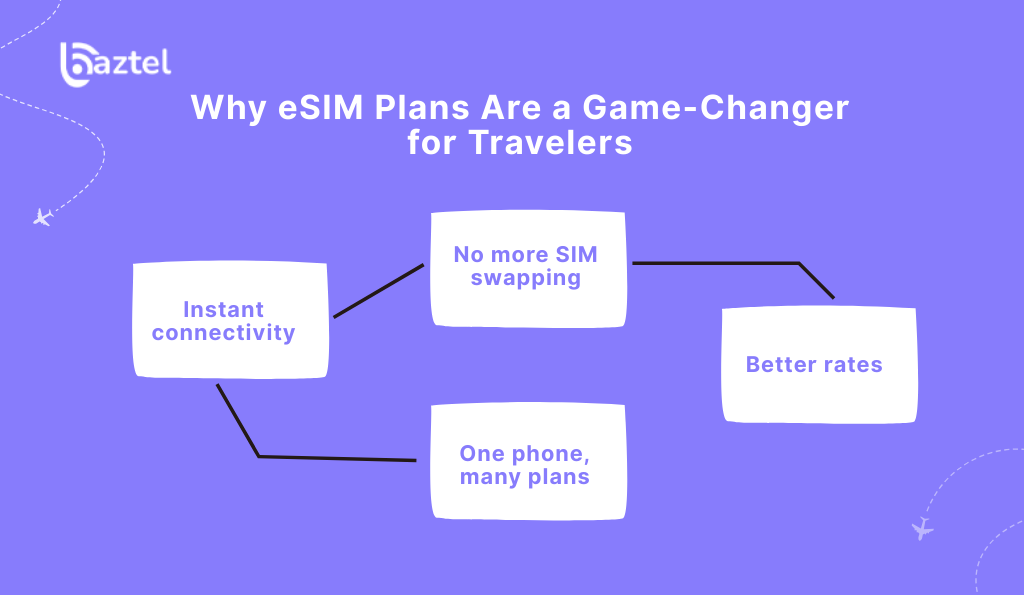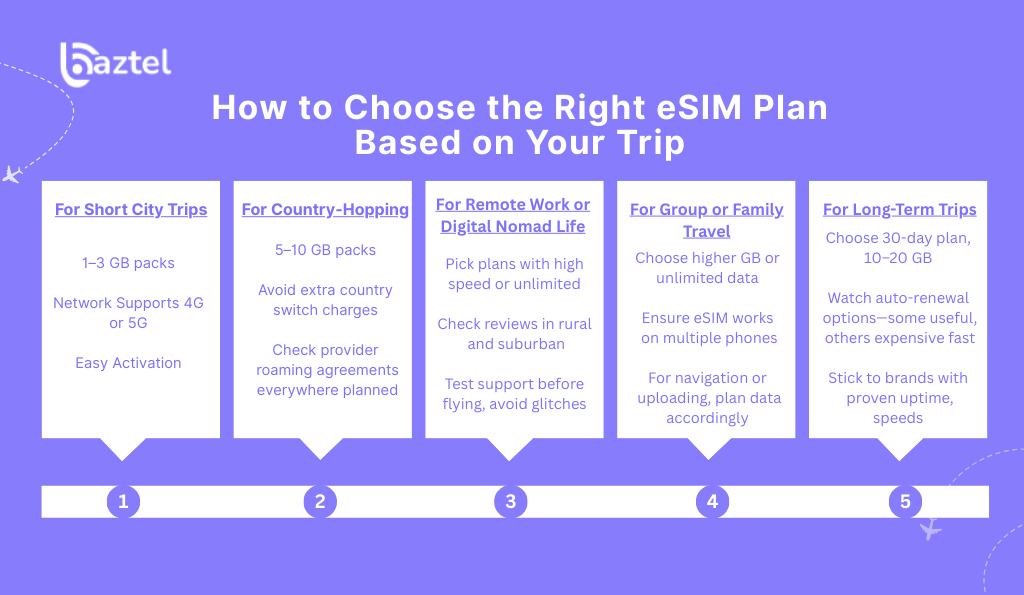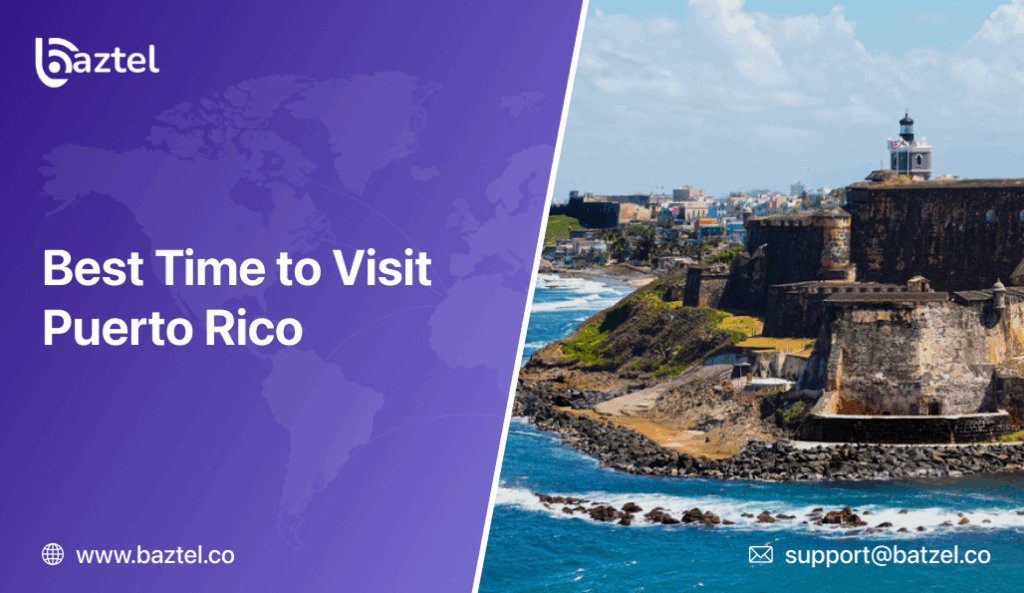Tired of juggling SIM cards every time you travel? You’re not alone. Frequent flyers often struggle with high roaming charges, limited local options, and the hassle of switching SIMs in every country. That’s where eSIM Plans for Travelers come in — no more queues at airport kiosks or fiddling with tiny SIM trays.
With a travel eSIM plan, you can land, connect, and go — straight from your phone. Whether you’re heading to Europe for work, hopping across Asia on vacation, or taking back-to-back international trips, an eSIM makes life easier. It’s fast, simple, and way more flexible than traditional SIM cards.
In this blog, we’ll walk you through the best eSIM Plans for Travelers in 2025 — real plans from trusted providers, with details on coverage, pricing, and ease of use. So if you’re a frequent traveler looking for a reliable way to stay connected, this guide is for you.
Why eSIM Plans Are a Game-Changer for Travelers

Remember the days of landing in a new country and rushing to find a SIM card kiosk? Or worse — paying huge roaming bills just to check your email? Those days are fading fast, thanks to eSIMs.
An eSIM (short for embedded SIM) lets you download a mobile plan directly to your phone — no physical card needed. It works instantly, often before you even step out of the airport. For travelers, this small shift makes a big difference:
- Instant connectivity: You can activate your plan while you’re still on the plane or using airport Wi-Fi. No need to hunt for a local store.
- No more SIM swapping: You don’t have to take out your existing SIM. eSIMs sit right alongside it on your device.
- One phone, many plans: Heading to multiple countries? You can store several travel plans and switch between them on the go.
- Better rates: Many travel eSIM plans offer cheaper data than international roaming from your home provider.
Whether you’re traveling for work or fun, this convenience can save time, money, and frustration. That’s why more frequent flyers are switching to eSIM Plans for Travelers every year.
What Makes a Great Travel eSIM Plan?

Not all eSIMs are built the same. Some give you lightning-fast data at airport prices. Others sound cheap but barely work once you’re outside the city. So, how do you know which travel eSIM plan is actually worth it?
Here’s what separates the good from the headache:
- Coverage That Matches Your Route
Going to one country? A local eSIM works best. Hopping across borders? You’ll need a regional or global plan. A great eSIM plan should cover all the places you’re visiting — without signal drop or surprise blackouts.
- Clear Data Limits (No Sneaky Throttling)
Check how much high-speed data you’re really getting. Some plans advertise “unlimited,” but slow down after 1–2 GB. A solid eSIM plan for travelers is upfront about speed caps and doesn’t kill your internet halfway through your trip.
- Easy Activation Process
The best plans take just a QR scan or app tap to get started. No account creation. No ID upload. No waiting 24 hours for activation. A few minutes should be all it takes.
- Transparent Pricing
You shouldn’t need a currency converter to understand the cost. Great eSIM providers list prices in USD or your home currency, with no hidden taxes or activation fees.
- Customer Support That Actually Replies
When you’re stuck in a foreign country with no data, you want fast help — not an email response in 48 hours. Look for reviews that mention live chat or prompt replies.
In short: the best eSIM Plans for Travelers are reliable, easy to use, and built with real-world travel in mind — not just flashy marketing.
Top 5 Best eSIM Plans for Frequent Travelers (2025 Picks)
Choosing the right eSIM can save you from airport stress, roaming charges, and slow data. No one wants to land in a new country and start hunting for Wi-Fi or overpriced SIM counters. That’s where the right eSIM makes life easier. It keeps you online from the moment you step off the plane — with no delays, no paperwork, and no roaming surprises. Below are 5 of the best eSIM Plans for Travelers in 2025. These aren’t random picks — they’re based on real user feedback and designed for people who travel often. Whether you’re off for work, a weekend escape, or hopping cities back-to-back, these plans have you covered.
1. BazTel – Best for Frequent Flyers Who Visit Multiple Countries
BazTel’s Global Travel eSIM offers excellent coverage in over 120 countries. Plans start from 1 GB for $4.99, and go up to 20 GB for $34. No contracts, just plug-and-play.
- Coverage: Global (Americas, Europe, Asia)
- Activation: Instant via QR code
- Why it’s great: Real-time support, no hidden charges, perfect for back-to-back trips.
2. Airalo – Best for First-Time eSIM Users
Airalo is beginner-friendly and offers localized plans as well as regional packs. Their interface is easy, and plans start as low as $5 for 1 GB.
- Coverage: Local, regional, global options
- Activation: In-app purchase and setup
- Why it’s great: Clean UI, affordable, great for solo or short trips.
3. Nomad – Best for Longer Stays
Nomad is ideal if you’re staying in one region for weeks. It offers better long-term data value, especially for Asia and Europe.
- Coverage: Focus on Asia, Europe, US
- Activation: App-based setup
- Why it’s great: Larger data packs for cheaper rates, good for digital nomads.
4. Holafly – Best for Unlimited Data Needs
Holafly offers unlimited data plans for specific countries — great for streamers, remote workers, or families. Slightly more expensive but worth it if you burn through data.
- Coverage: 160+ countries
- Activation: Email QR code
- Why it’s great: Unlimited data in many destinations, fast setup.
5. Ubigi – Best for Business Travelers
Ubigi stands out with stable connectivity, especially in airports and metro areas. It’s commonly used in IoT but works great for humans too!
- Coverage: Over 190 countries
- Activation: Quick setup through QR Code
- Why it’s great: Strong speeds, reliable coverage, works well for work travel.
These are some of the best eSIM Plans for Travelers in 2025. They’re practical, easy to activate, and save you from paying double on data while abroad.
How to Choose the Right eSIM Plan Based on Your Trip

There’s no one-size-fits-all when it comes to picking a travel eSIM plan. Every trip is different — so your data plan should be too. Someone spending a weekend in Rome doesn’t need the same setup as a remote worker living in Bali for three months. It all comes down to three things: your destination, the length of your trip, and how you plan to use your data. Are you just checking maps and uploading a few photos? Or are you taking work calls, streaming videos, and sharing hotspot with your laptop? The answers help you figure out what kind of travel eSIM plan fits best. Let’s break it down by use-case so you can choose smart and skip the stress.
1. For Short City Trips (3–5 days)
If you’re heading to a single country for a quick trip — say a weekend in Paris or a business meeting in Dubai — go for a local eSIM plan. For short getaways, there’s no need to complicate things. A local eSIM gives you instant access to data as soon as you land — no hunting for SIM kiosks at the airport or wasting time setting things up. Just scan the QR code, and you’re online. Whether you’re booking a cab, checking maps, or uploading stories, a simple 1 to 3 GB pack will do the job. These plans are usually more affordable, tailored to local networks, and work great for trips under 5 days. Plus, since you’re not jumping countries, you won’t need extra coverage or global roaming features — keeping things simple and cost-effective.
- Look for 1–3 GB packs.
- Make sure the network supports 4G or 5G in urban areas.
- Prioritize easy activation over fancy app features.
2. For Country-Hopping (Multi-City, Multi-Nation Trips)
Going across Europe or Southeast Asia? Choose a regional or global eSIM that covers all your stops.
If your trip includes multiple cities or countries, a regular local eSIM won’t cut it. You’ll waste time switching networks and risk losing coverage mid-trip. A regional or global eSIM makes things smooth — one setup, multiple countries, and no network drama. Whether you’re crossing borders by train in Europe or hopping flights around Southeast Asia, these plans keep you connected throughout. Go for 5–10 GB if you’re mostly using maps, social media, or emails. And always check if the eSIM includes roaming in all your destinations — some cheap plans sneak in hidden fees or drop coverage the moment you cross a border. One eSIM, multiple stamps on your passport — no reactivation needed.
- 5–10 GB is usually enough unless you’re doing a lot of streaming.
- Avoid plans that charge extra for each country switch.
- Check if the provider has roaming agreements in all your planned stops.
3. For Remote Work or Digital Nomad Life
If you’re working remotely, a stable internet is non-negotiable. When your income depends on staying online — whether you’re on Zoom calls, uploading files, or managing clients — patchy internet isn’t an option. That’s why choosing the right eSIM is crucial for digital nomads or remote professionals. Skip the basic plans. Go for high-speed or unlimited eSIMs that don’t throttle you after a couple of gigs. Read reviews from users in the regions you’re heading to — especially outside metro cities. Some eSIMs work great in capitals but struggle in suburbs or beach towns. Also, don’t wait till you land to test support — try chatting with customer service before your trip to see if they respond quickly. When you’re working on the go, reliable data isn’t a luxury — it’s survival.
- Pick plans offering high-speed data or unlimited use.
- Look for good reviews in rural or suburban areas — not just big cities.
- Test customer support before you fly — just in case you hit a setup glitch.
4. For Group or Family Travel
Traveling with others? Some providers let you share data or buy group plans at a discount. If you’re going on a trip with family, friends, or even coworkers, managing separate data plans for everyone can get messy and expensive. That’s where group eSIM plans come in handy. Some providers let you pool your data — so instead of buying 4 separate 5GB plans, you can get a single 20GB pack and share it across devices. It’s not just cheaper, it’s also easier to track. Make sure the eSIM you choose works well on different phones — especially if your group uses a mix of Androids and iPhones. And if one person in the group is heavy on navigation, uploads, or streaming, plan for that extra usage upfront. Shared plans only work when everyone knows the limit — or you’ll run out of data before you even reach your second stop.
- Go for higher GB packs or unlimited data.
- Make sure the eSIM works on multiple phone models (especially for iPhones and Androids).
- If someone’s using navigation or uploading a lot, factor that into your data needs.
5. For Long-Term Trips (Over 1 Month)
Skip the short-term plans — they’ll cost more over time. If you’re staying abroad for more than a month — whether for work, study, or slow travel — daily or weekly eSIM plans will quickly burn a hole in your pocket. Instead of juggling short-term top-ups, go for a long-duration plan from the start. A 30-day eSIM with 10–20 GB data usually offers much better value. Some providers even offer 90 or 180-day packs if you know your travel dates in advance. Also, watch for auto-renew options — they can be helpful but might charge you again if you’re not careful. Long trips need reliability, so pick a provider with a good support system and strong reviews for speed and uptime. You don’t want surprises halfway through your stay.
- Choose a 30-day plan with at least 10–20 GB.
- Watch for auto-renewal options (some are useful, others get expensive fast).
- Stick to brands with proven uptime and consistent speeds.
The best way to pick? Match the eSIM plan to your trip, not the other way around. Start with your destination, your data habits, and your budget — and the right plan will be easy to spot.
Final Thoughts: Are eSIM Plans for Travelers Worth It?
If you travel often — even just twice a year — switching to an eSIM plan for travelers is a smart move. It’s faster, simpler, and way more reliable than old-school roaming or buying SIMs at every airport.
You get to skip the long queues, avoid overpriced data packs, and stay connected from the moment you land. No need to fumble with SIM tools or worry about losing your local number. And with so many options now available — from local to global plans — there’s something for every type of trip and budget.
Sure, it takes a few minutes to get used to how it works. But once you’ve used an eSIM, you won’t go back.
Whether it’s a quick business trip, a family vacation, or months of remote work abroad, the best eSIM plans for travelers make sure your phone works just like it does at home — no drama, no delays.
So yes — they’re absolutely worth it.
Blog Author
Peter
Peter started BazTel.co to make mobile internet easier for travellers. He noticed how tough it was to find good network options while visiting new countries. That’s when he built BazTel — a place where anyone can buy eSIMs online without confusion or long steps. He believes tech should be simple and useful, not complicated. When he’s free, he likes to travel, test BazTel himself, and keep improving it based on real user problems.

 Botswana
Botswana Zambia
Zambia Congo
Congo Colombia
Colombia China mainland
China mainland Chile
Chile Chad
Chad Central African Republic
Central African Republic Canada
Canada Cameroon
Cameroon Cambodia
Cambodia Burkina Faso
Burkina Faso Bulgaria
Bulgaria Brunei Darussalam
Brunei Darussalam Brazil
Brazil Aland Islands
Aland Islands Bosnia and Herzegovina
Bosnia and Herzegovina Bolivia
Bolivia Belgium
Belgium Belarus
Belarus Bangladesh
Bangladesh Bahrain
Bahrain Azerbaijan
Azerbaijan Austria
Austria Australia
Australia Armenia
Armenia Argentina
Argentina Algeria
Algeria



